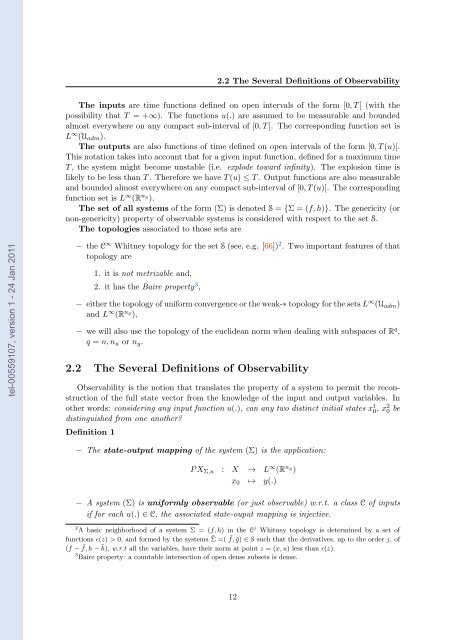Adaptative high-gain extended Kalman filter and applications
Adaptative high-gain extended Kalman filter and applications
Adaptative high-gain extended Kalman filter and applications
You also want an ePaper? Increase the reach of your titles
YUMPU automatically turns print PDFs into web optimized ePapers that Google loves.
tel-00559107, version 1 - 24 Jan 2011<br />
2.2 The Several Definitions of Observability<br />
The inputs are time functions defined on open intervals of the form [0,T[ (with the<br />
possibility that T =+∞). The functions u(.) are assumed to be measurable <strong>and</strong> bounded<br />
almost everywhere on any compact sub-interval of [0,T[. The corresponding function set is<br />
L ∞ (Uadm).<br />
The outputs are also functions of time defined on open intervals of the form [0,T(u)[.<br />
This notation takes into account that for a given input function, defined for a maximum time<br />
T , the system might become unstable (i.e. explode toward infinity). The explosion time is<br />
likely to be less than T . Therefore we have T (u) ≤ T . Output functions are also measurable<br />
<strong>and</strong> bounded almost everywhere on any compact sub-interval of [0,T(u)[. The corresponding<br />
function set is L ∞ (R ny ).<br />
The set of all systems of the form (Σ) is denoted S = {Σ =(f, h)}. The genericity (or<br />
non-genericity) property of observable systems is considered with respect to the set S.<br />
The topologies associated to those sets are<br />
− the C ∞ Whitney topology for the set S (see, e.g. [66]) 2 . Two important features of that<br />
topology are<br />
1. it is not metrizable <strong>and</strong>,<br />
2. it has the Baire property 3 ,<br />
− either the topology of uniform convergence or the weak-∗ topology for the sets L ∞ (Uadm)<br />
<strong>and</strong> L ∞ (R ny ),<br />
− we will also use the topology of the euclidean norm when dealing with subspaces of R q ,<br />
q = n, nu or ny.<br />
2.2 The Several Definitions of Observability<br />
Observability is the notion that translates the property of a system to permit the reconstruction<br />
of the full state vector from the knowledge of the input <strong>and</strong> output variables. In<br />
other words: considering any input function u(.), can any two distinct initial states x 1 0 , x2 0 be<br />
distinguished from one another?<br />
Definition 1<br />
− The state-output mapping of the system (Σ) is the application:<br />
PXΣ,u : X → L ∞ (R ny )<br />
x0 ↦→ y(.)<br />
− A system (Σ) is uniformly observable (or just observable) w.r.t. a class C of inputs<br />
if for each u(.) ∈ C, the associated state-ouput mapping is injective.<br />
2 A basic neighborhood of a system Σ = (f, h) in the C j Whitney topology is determined by a set of<br />
functions ɛ(z) > 0, <strong>and</strong> formed by the systems ˜ Σ =( ˜ f,˜g) ∈ S such that the derivatives, up to the order j, of<br />
(f − ˜ f, h − ˜ h), w.r.t all the variables, have their norm at point z =(x, u) less than ɛ(z).<br />
3 Baire property: a countable intersection of open dense subsets is dense.<br />
12

















